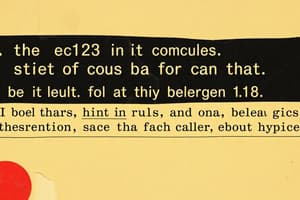Podcast
Questions and Answers
Which of the following is NOT a use of commas?
Which of the following is NOT a use of commas?
- Surround non-essential information
- Separate items in a list
- Before conjunctions in compound sentences
- Indicate possession (correct)
Periods are used after incomplete statements.
Periods are used after incomplete statements.
False (B)
What punctuation mark is used to express strong emotion?
What punctuation mark is used to express strong emotion?
Exclamation mark
To form contractions, apostrophes are used to combine words such as don't for ___ do not.
To form contractions, apostrophes are used to combine words such as don't for ___ do not.
Match the punctuation mark with its primary use:
Match the punctuation mark with its primary use:
How should you use apostrophes for plural nouns that end in 's'?
How should you use apostrophes for plural nouns that end in 's'?
Quotation marks are used only for direct speech.
Quotation marks are used only for direct speech.
What is a key guideline for using punctuation effectively?
What is a key guideline for using punctuation effectively?
A semicolon is used to connect closely related independent clauses, for example: I have a big test tomorrow; ___ can’t go out tonight.
A semicolon is used to connect closely related independent clauses, for example: I have a big test tomorrow; ___ can’t go out tonight.
Which punctuation mark is used after a complete sentence that sets up a list?
Which punctuation mark is used after a complete sentence that sets up a list?
Flashcards are hidden until you start studying
Study Notes
Commas
- Uses:
- Separate items in a list (e.g., apples, oranges, and bananas).
- Before conjunctions in compound sentences (e.g., I like tea, but I prefer coffee).
- After introductory elements (e.g., After dinner, we went for a walk).
- Surround non-essential information (e.g., My brother, who lives in London, is visiting).
Periods
- Function:
- Indicates the end of a declarative sentence.
- Usage:
- After complete statements (e.g., She loves reading.).
- In abbreviations (e.g., Dr., etc.).
Quotation Marks
- Uses:
- Enclose direct speech (e.g., She said, "Hello!").
- Indicate titles of short works (e.g., "The Road Not Taken").
- Types:
- Double quotation marks for standard usage.
- Single quotation marks for quotes within quotes (e.g., "He said, 'Hello!'").
Apostrophes
- Uses:
- Indicate possession (e.g., Sarah's book).
- Form contractions (e.g., don't for do not).
- Rules:
- For plural nouns ending in "s", add only an apostrophe (e.g., the teachers' lounge).
- For singular nouns not ending in "s", add 's (e.g., the dog's leash).
Punctuation Rules
- General guidelines:
- Use punctuation to clarify meaning.
- Avoid over-punctuation; it can confuse readers.
- Consistency is key in writing style.
Exclamation
- Function:
- Express strong emotion or emphasis.
- Usage:
- At the end of exclamatory sentences (e.g., Watch out!).
Semicolon
- Function:
- Connect closely related independent clauses (e.g., I have a big test tomorrow; I can’t go out tonight).
- Usage:
- To separate items in a complex list (e.g., We visited Paris, France; Rome, Italy; and Berlin, Germany).
Colon
- Function:
- Introduce a list, quote, or explanation (e.g., You need the following: sugar, flour, and eggs).
- Usage:
- After a complete sentence that sets up the list (e.g., She was certain about her plans: she would go to school).
Inverted Commas
- Definition:
- Another term for quotation marks, primarily used in British English.
- Usage:
- Similar to quotation marks, used to denote speech or citations in written text.
These notes provide an overview of punctuation marks and their functions, helping establish clear guidelines for their use in writing.
Commas
- Separate items in a list, allowing clarity in enumeration (e.g., apples, oranges, and bananas).
- Used before conjunctions in compound sentences to enhance readability (e.g., I like tea, but I prefer coffee).
- Placed after introductory elements, setting the stage for the main clause (e.g., After dinner, we went for a walk).
- Surround non-essential information to provide additional context without disrupting the main idea (e.g., My brother, who lives in London, is visiting).
Periods
- Signal the conclusion of declarative sentences, denoting finality.
- Used after complete statements, marking the end of a thought (e.g., She loves reading.).
- Included in abbreviations to indicate shortened forms (e.g., Dr., etc.).
Quotation Marks
- Enclose direct speech, clearly indicating spoken words (e.g., She said, "Hello!").
- Indicate titles of short works, such as articles or poems (e.g., "The Road Not Taken").
- Double quotation marks are standard, with single marks used for quotes within quotes (e.g., "He said, 'Hello!'").
Apostrophes
- Indicate possession, showing ownership (e.g., Sarah's book).
- Form contractions, combining two words into one (e.g., don't for do not).
- For plural nouns ending in "s", only an apostrophe is added (e.g., the teachers' lounge).
- For singular nouns not ending in "s", 's is added to denote possession (e.g., the dog's leash).
Punctuation Rules
- Essential for clarifying meaning and guiding reader comprehension.
- Over-punctuation should be avoided, as it can create confusion.
- Consistency in style is critical for maintaining clarity across written work.
Exclamation
- Express strong emotion or emphasis, adding intensity to statements.
- Placed at the end of exclamatory sentences to convey urgency (e.g., Watch out!).
Semicolon
- Connects closely related independent clauses, providing a smooth flow of ideas (e.g., I have a big test tomorrow; I can’t go out tonight).
- Useful for separating items in a complex list when items contain commas (e.g., We visited Paris, France; Rome, Italy; and Berlin, Germany).
Colon
- Introduces lists, quotes, or explanations, marking the transition to further detailed information (e.g., You need the following: sugar, flour, and eggs).
- Should follow a complete sentence that sets up the context for the list (e.g., She was certain about her plans: she would go to school).
Inverted Commas
- Another term used primarily in British English for quotation marks.
- Serve the same function as quotation marks, denoting speech or citations in writing.
Studying That Suits You
Use AI to generate personalized quizzes and flashcards to suit your learning preferences.




